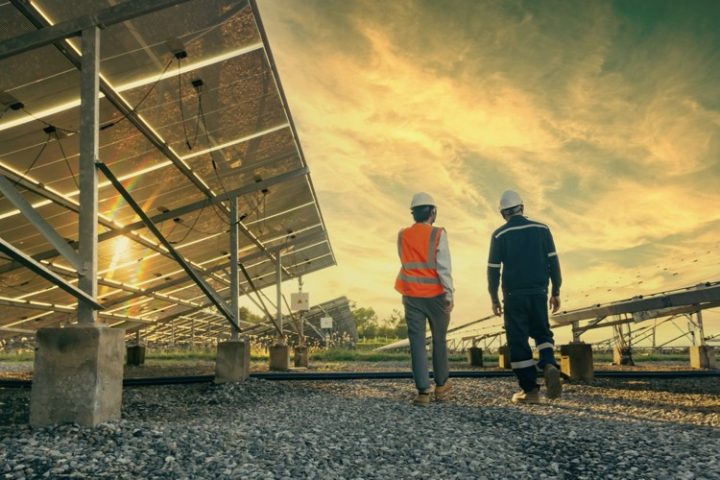
Climate alarmists like to claim that fossil fuels and the release of greenhouse gases associated with them are destroying the climate of our planet. They also like to claim that so-called renewable energy, such as solar power, is the key to saving our climate from ourselves.
But there’s a dirty little secret with solar energy. The solar panels that are meant to clean up our environment aren’t really all that clean themselves.
Speaking with the Epoch Times’ “The Nation Speaks,” environmental expert Michael Shellenberger talked about how he and his colleagues stumbled upon that fact a few years ago.
“We did just a simple calculation and we discovered that solar panels produce 2-300 times more hazardous waste than the high level waste that comes out of nuclear power plants,” Shellenberger explained.
A recent study published in the Harvard Business Review backed up Shellenberger’s claim. The study concluded that factors including tax credits, improved efficiency, and a sharp decline in production costs have been causing solar power enthusiasts to replace panels far sooner than expected, which will eventually lead to a problem of what to do with the old solar panels. And it’s not just a simple matter of putting them in a landfill.
“Economic incentives are rapidly aligning to encourage customers to trade their existing panels for newer, cheaper, more efficient models. In an industry where circularity solutions such as recycling remain woefully inadequate, the sheer volume of discarded panels will soon pose a risk of existentially damaging proportions,” the study’s authors say.
Solar panels contain materials that can be extremely hazardous to the environment, and the current craze in solar energy is causing panels to be replaced and discarded far faster than originally expected. Among the dangerous materials used in solar panels are cadmium telluride, copper indium selenide, cadmium gallium (di)selenide, copper indium gallium (di)selenide, hexafluoroethane, lead, and polyvinyl fluoride.
Silicon tetrachloride is another highly toxic chemical associated with solar panels; it is produced as a byproduct of making the crystalline silicon used in solar panels. Even the pro-solar website EnergySage warns against it.
“One of the most toxic chemicals created as a byproduct of this process is silicon tetrachloride. This chemical, if not handled and disposed of properly, can lead to burns on your skin, harmful air pollutants that increase lung disease, and if exposed to water can release hydrochloric acid, which is a corrosive substance bad for human and environmental health.”
Some of the materials in solar panels can be recycled but it’s a costly process — $20 to $30 to recycle one panel vs. $1 to $2 to simply send it to a landfill where it could break. And if those panels break, they also contain heavy metals such as lead that could be released as a toxic cloud into the environment.
“It’s hazardous waste,” Shellenberger said. “Airelized lead is not something that we’ve allowed people to be exposed to for over half a century because we know it causes brain damage. So it’s as dangerous as lead paint, it’s as dangerous as all of the lead-based materials that society has basically phased out until now.”
So, the solar energy transformation that climate alarmists have been clamoring for may turn out to be the lead-based paint problem of the twenty-first century.
The International Renewable Energy Agency (IRENA) has been spinning the solar panel recycling problem as a booming future industry where billions of dollars could be made. But IRENA’s original projections showed that consumers would keep their old-technology solar panels for at least 30 years — giving the potential industry time to get ready.
Those future boom industries are nowhere close to ready and the problem is at their doorstep.
Government incentives and improved technology are causing consumers to replace their old solar panels much earlier than anticipated. The Harvard Business Review’s study concludes that IRENA’s projections are way off and that replacements may “produce 50 times more waste in just four years than IRENA anticipates.”
And that study only looked at residential installations. Commercial and industrial installations could make the situation far worse.
“We’ve been in a sort of hypnotic trance,” Shellenberger said, referring to the public’s perception of solar panels as a climate and environmentally friendly way to generate electricity.
“It’s a spiritual pursuit,” Shellenberger surmised. “There’s the idea that … we’ll protect the natural environment by being dependent on natural energy flows like sunlight. It’s not a scientific view. It actually is worse for the environment.”
The environmental hazards associated with solar power are potentially worse than the ones posed by another low-emission technology — nuclear power. Yet the climate alarmists eschew nuclear power in favor of solar, which they somehow see as “clean” energy as opposed to their prejudice against the far more efficient nuclear alternative.
If the climatistas were truly serious about producing low-emission energy for the masses, they would not be excluding nuclear power from the equation. While nuclear power also produces waste products, the amount is small compared to the energy produced and are confined to the plant — the cooling towers at a nuclear plant emit water vapor; there are no smokestacks.



